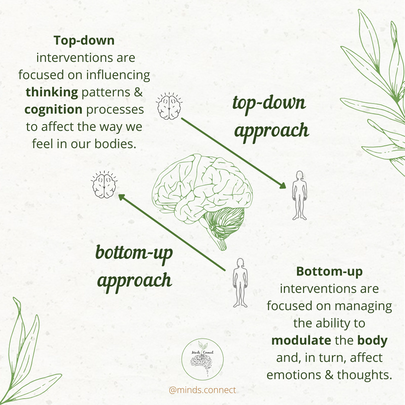Trauma robs you of the feeling of being in charge of yourself. In order to regain control over yourself, trauma needs to be revisited. However, trauma is much more than a story about something that happened. The emotions and sensations imprinted during trauma are experienced not only as memories but as disruptive physical reactions in the present.
Once you learn to tolerate physical experiences based on trauma, you can begin to make sense of them, to integrate them into your life history and personal identity. Integrating trauma also means putting it in its place on a body level. Bessel van der Kolk, M.D., believes that contemporary mind-body interventions actually promote change by forging communication and restoring the balance between the rational and emotional brain systems through a third pathway: the medial prefrontal cortex.This area manages the emotion regulation/inhibition process and it is also connected to the amygdala, that is the threat detector of our brain. Mindfulness practices, for example, help to strengthen the medial prefrontal cortex increasing emotional regulation capacity. Neuroscience research shows that the only way we can change the way we feel is by becoming aware of our inner experience and learning to befriend what is going on inside ourselves. Traditional talk-based psychotherapy, and most cognitively-oriented trauma-focused therapies, are viewed as taking a top-down approach to treatment. Most often this involves efforts to resolve trauma symptoms by working with the dorsolateral prefrontal cortex, the area of the brain most responsible for logic and reason. A top-down approach in psychotherapy starts with looking at how the mind is interpreting information, how do we make sense of events. It focuses first on the cognitive aspect and targets the frontal lobes. The higher brain is the place where logic lives. A logic-first approach can be less effective because, if your brain has experienced trauma, the trauma response de-activates the thinking areas, and activates the lower areas of the brain. Some of the top-down therapies are: - Talking therapies:
The bottom-up approach begins with information acquired from the body’s sensations. The bottom-up approach understands that feelings and body sensations happen first, before it access the rational areas of our brain. Therefore, bottom-up interventions work by accessing the limbic system (emotional brain) and by directly targeting sensory receptors located throughout the body. The idea is to develop a sense of safety within your own body. Trauma-informed therapy creates healing relationships in which it is safe to begin to look at the reasons why a person feels unsafe (and unable to control thoughts and feelings when triggered), without being overwhelmed by taking a tritration approach. Titration is the skill set that involves managing the speed of processing by slowing down the activation/ arousal responses. The healing relationships include the therapist-client relationship and the client’s own relationship with himself or herself. This is why it is so important that you feel safe and connected with your therapist. To activate this bottom-up process, the following activities could be used: - Exercise - Rhythmic movement - Deep, relaxed diaphragmatic breathing - Synchrony exercises between breathing and heart rate Some of the bottom-up therapies are: - Sensorimotor therapy - Somatic experiencing - Yoga therapy - Eye Movement Desensitization and Reprocessing (EMDR) - Ego states psychotherapy / Internal Family Systems (IFS) - Mindfulness-based therapies - Neurofeedback While either path can help a client begin to self-regulate, it is important to think about what a specific person may need. A blend of both can help individuals to begin to cope with their bodily experiences of trauma while they begin to think and feel differently about their experiences, their emotions, and their sense of self. See more about this in my Instagram post. Please leave your comments below!
1 Comment
9/6/2023 02:47:35
Unfortunately, the pharmaceutical industry greatly financially gains from the continual sedation/concealment of trauma's symptoms via tranquilizers and/or antidepressants.
Reply
Leave a Reply. |
AuthorHi there! Archives
January 2022
Categories |

 RSS Feed
RSS Feed
